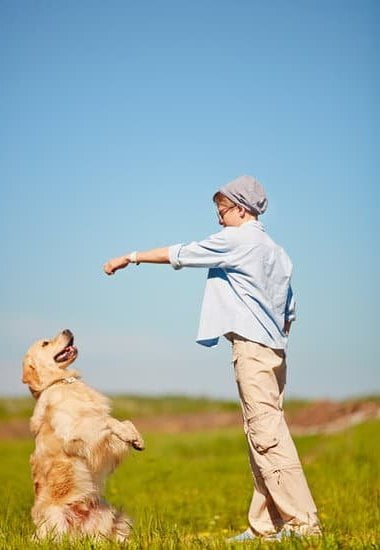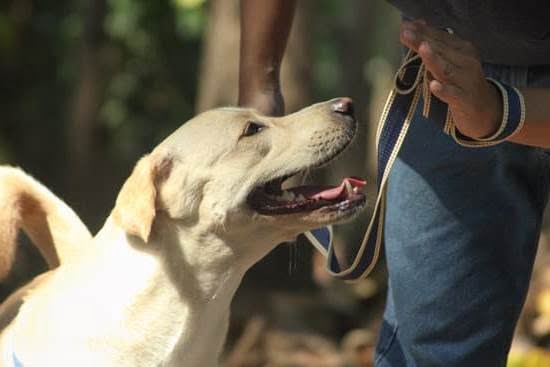Introduction
Training a dog is an exceptionally rewarding experience; not only does it allow us to form long-lasting, meaningful relationships with our canine companions, but it also provides numerous benefits both for the owner and the dog. Training your dog can enhance their quality of life by improving their behavior and creating healthier relationships between owners and dogs.
Training your pet helps them to better fit into our human world by providing structure, rules and boundaries that are necessary for dogs in order to learn appropriate behaviors while living among humans. As they learn basic obedience commands such as ‘sit’ and ‘come’, they become more likely to follow those commands when given in different surroundings outside of training sessions. This improves safety which makes everyday tasks such as taking them on walks much easier and enjoyable.
In addition to discipline, consistency is one of the most important parts of successfully training your dog. With consistent practice during each training session, your pup will learn how to follow instructions quicker and remember learned behaviors for future commands; this significantly reduces their opportunity for misbehavior. Regularly practicing established routines teaches dogs that expected behaviors bring positive reinforcement from owners which further strengthens the bond between them.
The benefits associated with having a trained dog don’t end there; through the process of teaching dogs certain behaviors, behavioral problems like barking and digging may be reduced or even eliminated entirely without physical punishment or negative reinforcement tactics that could have damaging effects on their mental state. Dogs become more relaxed around unfamiliar people or animals when they understand what is expected from them in different situations. A calmer demeanor means that owners can take their pets around town while still maintaining restrain, proper etiquette and good manners under social settings.
Not only do owners benefit from these changes in behavior due to regular training sessions with their pups but so do the dogs themselves; socialization helps these loyal companions interact better with each other which promotes healthier activities during playtime and creates enriched lifestyles filled with positive rewards instead of fear-based punishments commonly seen with untrained animals. Additionally, as confidence increases so does trust levels between owners – allowing them more freedom regarding off-leash activity compared to unpredictable animal behavior found off leash when unclear rules exist among unruly pack dynamics which may cause safety issues within the home or public areas where the Dog resides . With training comes knowledge from both sides thereby constructing a solid foundation of understanding between you and your furry friend!
Physical Benefits
I train my dog to keep her strong, healthy and fit. By incorporating a physical training program into her routine and teaching her new commands and tricks, I am helping to build and maintain the muscle definition in her body. Training my dog provides an excellent way for me to bond with her while also providing a much-needed workout for my furry friend. With an appropriate and balanced exercise plan, I can help strengthen and define all of major muscles groups in my dog’s body – everything from the neck and chest area all the way down to their tail. Physically stimulating activities like running, swimming, socializing, agility courses can help my pup stay strong, flexible and energized. Not only will this development of strength result in fantastic physical benefits, but it will also aid in keeping our canine companion mentally alert. As any owner knows -a tired pup is a happy pup!
Behavioral Benefits
Training my dog is incredibly important to me. Not only because of safety concerns, but also because I am invested in developing a strong bond with my pet. Training encourages communication between us and helps us better understand each other’s language — both verbal and nonverbal. Training helps me better handle any behavioral issues that come up and helps keep my dog more secure and stable during upheaval or stressful situations. Training also provides a healthy outlet for my dog’s energy, concentration, intelligence, and curiosity so they do not become frustrated or destructive.
Training dogs can have numerous additional benefits as well. Doing regular training helps build trust and respect between me and my dog by establishing boundaries. By teaching commands such as ‘sit’ or ‘stay’, I also create structure in our relationship which allows me to shape their behavior positively in the long run. Furthermore, training sessions are important opportunities for socialization, providing mental stimulation that keeps them occupied while building good relationships with both people and other animals. Finally, regular exercise fosters increased physical health too, helping to prevent many behavioral problems associated with boredom or lack of exercise. Overall, effective training can truly enrich the life of your furry companion in immeasurable ways!
Mental Stimulation
Training my dog not only encourages physical activity, but mental development as well. Training is often seen as teaching a dog to perform physical commands such as sitting, staying, or fetching. What many don’t realize is that training also provides mental stimulation and cognitive development. Every time a training session occurs, it’s an opportunity for my dog to learn something new. During these sessions, I reward him with praise and treats when he successfully completes the task at hand so that he understands what is expected of him. My dog is constantly exposed to novel situations which enable him to think and make new connections. As his training progresses, he retains more information which facilitates learning even quicker – in effect creating a more well-rounded individual capable of responding quickly in any environment life throws at him!
Proper Socialization
I train my dog for proper socialization in order to ensure that he is comfortable and happy with the people and animals he encounters in his life. This starts by teaching him basic commands such as sit and stay, which help him understand how to interact appropriately with others. I also spend time walking and playing with him so that he can feel secure around other people and animals. Arranging playdates or having a pet sitter come over while we are out of town are great ways to give him ample practice dealing with new situations. Additionally, I take classes with an experienced trainer who specializes in socialization to make sure my pup is well versed in positive interactions with other pets and people in a variety of environments. Working together, we develop behaviors that build trust between my pup and others, while making it clear that everyone is safe and respected in his presence.
Improving Your Relationship
My relationship with my dog is one of the most important relationships in my life. That is why I train my dog; because training helps to reinforce our bond and improve our relationship. By taking the time each day to properly train my dog, we are able to build trust and understanding as well as help channel their energy into more positive and productive activities.
Through positive training, I have learned how to better communicate with my pet and ensure that both of us are learning valuable lessons along the way. With proper positive reinforcement techniques, good behaviors are encouraged while bad behaviors are discouraged in ways that benefit both me and my pet. We learn from one another during these training sessions, leading to a much stronger bond built on mutual respect.
I also understand the importance of ensuring that these training sessions remain fun and lighthearted. Allowing myself and my pet to enjoy these sessions helps create an atmosphere of positivity which further strengthens our relationship even more so than before. With each successful lesson achieved by both of us, I begin to observe a much higher level of joy between us which makes the entire process even more worthwhile.
At the end of the day, this journey together has been immensely rewarding in terms of improving our relationship with one another. I’m thankful every day that we opted to take up this new venture into positive dog training!
Stimulating the Mind
Training my dog has become an important part of my routine. As any pet owner knows, a healthy and happy pup requires plenty of attention as well as social interactions. One way I ensure both for my four-legged friend is to regularly train him. Through training, I’m able to stimulate his mind and teach him basic commands like “sit,” “stay,” and “come.” But the real benefits come from teaching more advanced skills that require problem-solving and thinking on the fly – such as agility training, scent work, and tricks. All these activities involve using complex thought processes to figure out what is asked of them, which can greatly enhance their overall intelligence. The best part? Instead of always relying on treats or toys to keep them entertained, they are being actively engaged in a fun activity that exercises both their bodies and minds. Training also strengthens the bond between us; it’s a wonderful opportunity to spend quality time together while he learns new things!
Formal Training
I train my dog for many different reasons. The main purpose of formal training is to ensure that he adheres to basic obedience commands and is a well-mannered pet in public. As part of the formal training process, I use positive reinforcement techniques such as rewards, praise, and modified clicker training so that my dog clearly understands what is expected of him. I also keep my training sessions short and engaging so that my dog remains focused and attentive throughout them.
Another key benefit of formal training for your pet is the development of an even deeper connection between you two. Through respect, trust, consistency and patience with the teaching process, both owner and pet form a mutual understanding of each other’s behaviors. Additionally, it can also help build behavior modifications related to socialization issues or unwanted habits such as jumping or barking. Furthermore, by consistently doing these exercises with your dog it can also provide mental stimulation as well as physical exercise which are both essential for his overall health and wellbeing. Lastly, proper behavior around visitors can be developed through formal command drills which help create a welcoming atmosphere when friends and family come to visit.
Positive Reinforcement
I believe that positive reinforcement is a powerful tool when it comes to training my dog. Positive reinforcement gives your dog the chance to learn new commands, builds trust between you and your pet, and strengthens the bond between the two of you. Positive reinforcement also provides quick results, builds confidence in your dog, and initiates a happy response when used correctly.
When incorporating positive reinforcement into my training sessions I must adhere to a few guidelines. First, I must provide great timing of the reward; the reward should be given quickly after successful completion of a task. Secondly, I must use the correct type of reward. The reward should be something that is very desirable to my dog in order for him/her to be motivated by it during training sessions. Thirdly, rewards are presented for specific behaviors only; giving rewards for undesired behaviors may lead to confusion or result in undesirable outcomes at certain times during our training together. Lastly, rewards must always be given within a comfortable distance; this helps avoid any stress or fear on my part or that of my pet when engaging in activities together.
I believe these guidelines are key when creating successful outcomes during each session with my furry friend!
Tips for Training Your Dog
Training your dog can be a rewarding experience and it can help you form a stronger bond with your dog. Training provides mental stimulation that can keep your pet from becoming bored or restless, and it also encourages good behavior. Here are some tips for getting started:
1. Start with basic commands. The most basic commands include “sit”, “down”, “stay”, and “come”. When teaching these commands, use treats as a reward for proper responses.
2. Keep training sessions short and positive. Make sure each session lasts no longer than 10 minutes or so and try to end on a positive note so your dog associates training with something they enjoy doing.
3. Be patient when teaching new tricks or revising old commands to reduce confusion in your pup. It is important to give clear verbal cues in order for them to properly understand what you expect of them.
4. Never punish your pet during training sessions as this will only set back their progress and make them afraid of you or the activity itself. Instead, praise them when they get something right even if it was unintentional on their part.. This will encourage more productive behaviour in the future as they know what pleases you and what doesn’t!
5. Lastly, have fun! The whole point of training is to create an enjoyable experience between both of you and there’s nothing wrong with changing up the exercises every once in awhile to keep things interesting! You’ll find yourself laughing at all the silly mistakes your pup makes along the way too if you watch them long enough!
Conclusion
Training your dog is the best option for a happy and healthy pet, as it gives them the opportunity to fulfill their natural desire to interact and learn. And, just like us, animals benefit from routine and consistency. When your dog gets older, teaching them lifelong skills encourages not only their understanding of boundaries but also their emotional growth. With daily reinforcement of learned commands, you can expect a well-behaved, obedient canine companion that respects household rules and knows how to interact with people and other animals in appropriate ways. Overall, taking the time to teach your pet puppy manners will result in forming a lasting bond between you two that will last throughout the years to come.

Welcome to the blog! I am a professional dog trainer and have been working with dogs for many years. In this blog, I will be discussing various topics related to dog training, including tips, tricks, and advice. I hope you find this information helpful and informative. Thanks for reading!





